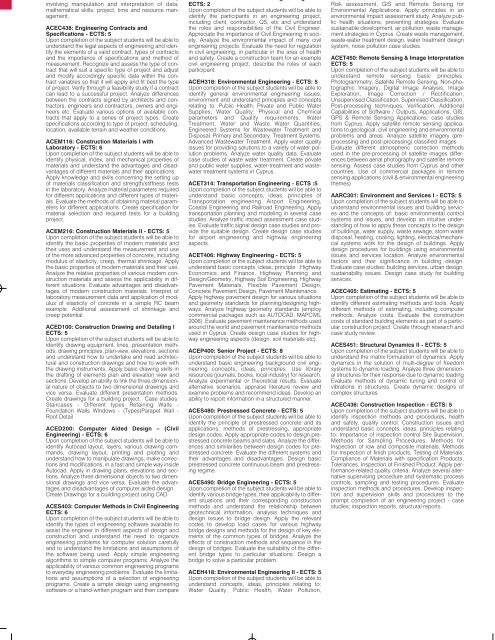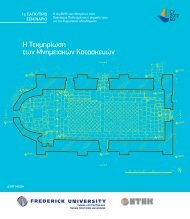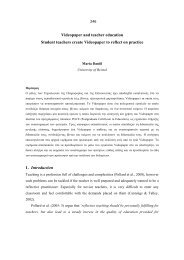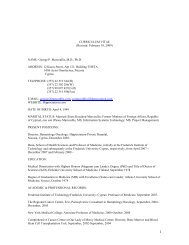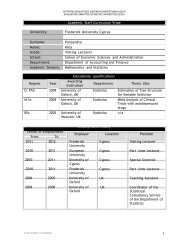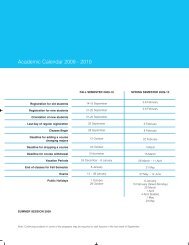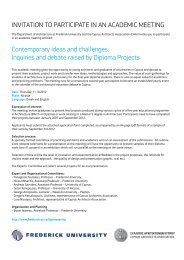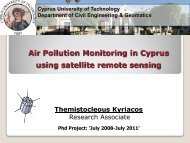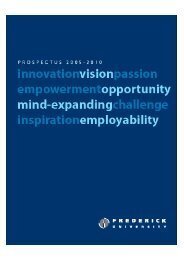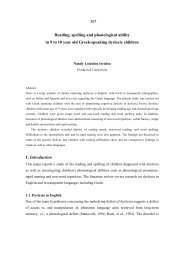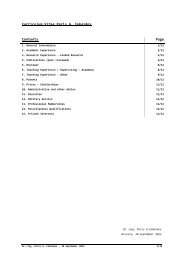Untitled - Frederick University
Untitled - Frederick University
Untitled - Frederick University
Create successful ePaper yourself
Turn your PDF publications into a flip-book with our unique Google optimized e-Paper software.
involving manipulation and interpretation of data;<br />
mathematical skills; project, time and resource management.<br />
ACEC438: Engineering Contracts and<br />
Specifications - ECTS: 5<br />
Upon completion of the subject students will be able to<br />
understand the legal aspects of engineering and identify<br />
the elements of a valid contract, types of contracts<br />
and the importance of specifications and method of<br />
measurement. Recognize and assess the type of contract<br />
that will suit a specific type of project and adjust<br />
and modify accordingly specific data within the contract<br />
variables so that it will apply and fit best the type<br />
of project. Verify through a feasibility study if a contract<br />
can lead to a successful project. Analyze differences<br />
between the contracts signed by architects and contractors,<br />
engineers and contractors, owners and engineers<br />
etc. Evaluate various options of available contracts<br />
that apply to a series of project types. Create<br />
specifications according to type of project, scheduling,<br />
location, available terrain and weather conditions.<br />
ACEM116: Construction Materials I with<br />
Laboratory - ECTS: 6<br />
Upon completion of the subject students will be able to<br />
identify physical, index, and mechanical properties of<br />
materials and understand the advantages and disadvantages<br />
of different materials and their applications.<br />
Apply knowledge and skills concerning the setting up<br />
of materials classification and strength/stiffness tests<br />
in the laboratory. Analyze material parameters required<br />
for different applications and different types of materials.<br />
Evaluate the methods of obtaining material parameters<br />
for different applications. Create specification for<br />
material selection and required tests for a building<br />
project.<br />
ACEM216: Construction Materials II - ECTS: 5<br />
Upon completion of the subject students will be able to<br />
identify the basic properties of modern materials and<br />
their uses and understand the measurement and use<br />
of the more advanced properties of concrete, including<br />
modulus of elasticity, creep, thermal shrinkage. Apply<br />
the basic properties of modern materials and their use.<br />
Analyze the relative properties of various modern construction<br />
materials and assess the applicability in different<br />
situations. Evaluate advantages and disadvantages<br />
of modern construction materials. Interpret of<br />
laboratory measurement data and application of modulus<br />
of elasticity of concrete in a simple RC beam<br />
example. Additional assessment of shrinkage and<br />
creep potential.<br />
ACED100: Construction Drawing and Detailing I<br />
ECTS: 5<br />
Upon completion of the subject students will be able to<br />
identify drawing equipment, lines, presentation methods,<br />
drawing principles, plan-view, elevations, sections<br />
and understand how to undertake and read architectural<br />
and construction drawings and how to work with<br />
the drawing instruments. Apply basic drawing skills in<br />
the drafting of elements plan and elevation view and<br />
sections. Develop an ability to link the three dimensional<br />
nature of objects to two dimensional drawings and<br />
vice versa. Evaluate different presentation methods.<br />
Create drawings for a building project. Case studies:<br />
Staircases - Different types Retaining Walls -<br />
Foundation Walls Windows - (Types)Parapet Wall -<br />
Roof Detail<br />
ACED200: Computer Aided Design – (Civil<br />
Engineering) - ECTS: 6<br />
Upon completion of the subject students will be able to<br />
identify Autocad layout, layers, various drawing commands,<br />
drawing layout, printing and plotting and<br />
understand how to manipulate drawings, make corrections<br />
and modifications, in a fast and simple way inside<br />
Autocad. Apply in drawing plans, elevations and sections.<br />
Analyze three dimensional objects to two dimensional<br />
drawings and vice versa. Evaluate the advantages<br />
and disadvantages of computer aided design<br />
Create Drawings for a building project using CAD.<br />
ACES403: Computer Methods in Civil Engineering<br />
ECTS: 6<br />
Upon completion of the subject students will be able to<br />
identify the types of engineering software available to<br />
assist the engineer in different aspects of design and<br />
construction and understand the need to organize<br />
engineering problems for computer solution carefully<br />
and to understand the limitations and assumptions of<br />
the software being used. Apply simple engineering<br />
algorithms to simple computer programs. Analyze the<br />
applicability of various common engineering programs<br />
to everyday engineering problems. Evaluate the limitations<br />
and assumptions of a selection of engineering<br />
programs. Create a simple design using engineering<br />
software or a hand-written program and then compare<br />
ECTS: 2<br />
Upon completion of the subject students will be able to<br />
identify the participants in an engineering project,<br />
including client, contractor, QS, etc and understand<br />
the roles and responsibilities of the Civil Engineer.<br />
Appreciate the importance of Civil Engineering in society.<br />
Analyze the environmental impact of many civil<br />
engineering projects. Evaluate the need for regulation<br />
in civil engineering, in particular in the area of health<br />
and safety. Create a construction team for an example<br />
civil engineering project, describe the roles of each<br />
participant.<br />
ACEH318: Environmental Engineering - ECTS: 5<br />
Upon completion of the subject students will be able to<br />
identify general environmental engineering issues,<br />
environment and understand principles and concepts<br />
relating to: Public Health, Private and Public Water<br />
Supplies, Water Quality: Physical and Chemical<br />
parameters and Quality requirements, Water<br />
Treatment, Water and Waste Water Quantities,<br />
Engineered Systems for Wastewater Treatment and<br />
Disposal. Primary and Secondary. Treatment Systems.<br />
Advanced Wastewater Treatment. Apply water quality<br />
issues for providing solutions to a variety of water pollution<br />
problems. Analyze water quality data. Evaluate<br />
case studies of waste water treatment. Create private<br />
and public water supplies, water-treatment and wastewater<br />
treatment systems in Cyprus.<br />
ACET314: Transportation Engineering - ECTS :5<br />
Upon completion of the subject students will be able to<br />
understand basic concepts, ideas, principles of<br />
Transportation engineering Airport Engineering,<br />
Coastal Engineering and Railroad Engineering. Apply<br />
transportation planning and modeling in several case<br />
studies. Analyze traffic impact assessment case studies.<br />
Evaluate traffic signal design case studies and provide<br />
the suitable design. Create design case studies<br />
for airport engineering and highway engineering<br />
aspects.<br />
ACET406: Highway Engineering - ECTS: 5<br />
Upon completion of the subject students will be able to<br />
understand basic concepts, ideas, principle :Highway<br />
Economics and Finance, Highway Planning and<br />
Design/Geometry, Highway Soil Engineering, Highway<br />
Pavement Materials, Flexible Pavement Design,<br />
Concrete Pavement Design, Pavement Maintenance.<br />
Apply highway pavement design for various situations<br />
and geometry standards for planning/designing highways.<br />
Analyze highway geometry standards (employ<br />
commercial packages such as AUTOCAD, MAPCIVIL<br />
2006). Evaluate pavement maintenance methods used<br />
around the world and pavement maintenance methods<br />
used in Cyprus. Create design case studies for highway<br />
engineering aspects (design, soil materials etc).<br />
ACEP400: Senior Project - ECTS: 8<br />
Upon completion of the subject students will be able to<br />
understand basic engineering background civil engineering<br />
concepts, ideas, principles. Use library<br />
resources (journals, books, local industry) for research.<br />
Analyze experimental or theoretical results. Evaluate<br />
alternative scenarios, appraise literature review and<br />
examine problems and recommend ideas. Develop an<br />
ability to report information in a structured manner.<br />
ACES480: Prestressed Concrete - ECTS: 5<br />
Upon completion of the subject students will be able to<br />
identify the principle of prestressed concrete and its<br />
applications, methods of prestressing, appropriate<br />
design codes. Apply appropriate codes to design prestressed<br />
concrete beams and slabs. Analyze the differences<br />
and similarities between design codes for prestressed<br />
concrete. Evaluate the different systems and<br />
their advantages and disadvantages. Design basic<br />
prestressed concrete continuous beam and prestressing<br />
regime.<br />
ACES490: Bridge Engineering - ECTS: 5<br />
Upon completion of the subject students will be able to<br />
identify various bridge types, their applicability to different<br />
situations and their corresponding construction<br />
methods and understand the relationship between<br />
geotechnical information, analysis techniques and<br />
design issues to bridge design. Apply the relevant<br />
codes to develop load cases for various highway<br />
bridge designs and methods for the design of key elements<br />
of the common types of bridges. Analyze the<br />
effects of construction methods and sequence in the<br />
design of bridges. Evaluate the suitability of the different<br />
bridge types to particular situations. Design a<br />
bridge to solve a particular problem.<br />
ACEH418: Environmental Engineering II - ECTS: 5<br />
Upon completion of the subject students will be able to<br />
understand concepts, ideas, principles relating to:<br />
Water Quality, Public Health, Water Pollution,<br />
Risk assessment, GIS and Remote Sensing for<br />
Environmental Applications. Apply principles in an<br />
environmental impact assessment study. Analyze public<br />
health situations, preventing strategies. Evaluate<br />
sustainable development, air pollution, waste management<br />
strategies in Cyprus. Create waste management,<br />
waste-water treatment design, water treatment design<br />
system, noise pollution case studies.<br />
ACET450: Remote Sensing & Image Interpretation<br />
ECTS: 5<br />
Upon completion of the subject students will be able to<br />
understand remote sensing basic principles:<br />
Photogrammetry, Satellite Remote Sensing, Non-photographic<br />
Imagery, Digital Image Analysis, Image<br />
Exploration, Image Correction / Rectification,<br />
Unsupervised Classification, Supervised Classification,<br />
Post-processing techniques, Verification, Additional<br />
Capabilities of Software / Outputs, Applications, GIS,<br />
GPS & Remote Sensing Applications: case studies<br />
from Cyprus. Apply satellite remote sensing applications<br />
to geological, civil engineering and environmental<br />
problems and areas. Analyze satellite imagery (preprocessing<br />
and post-processing) classified images<br />
Evaluate different atmospheric correction methods<br />
used in the pre-processing of satellite images differences<br />
between aerial photography and satellite remote<br />
sensing. Assess case studies from Cyprus and other<br />
countries. Use of commercial packages in remote<br />
sensing applications (civil & environmental engineering<br />
themes)<br />
AARC301: Environment and Services I - ECTS: 5<br />
Upon completion of the subject students will be able to<br />
understand environmental issues and building services<br />
and the concepts of: basic environmental control<br />
systems and issues, and develop an intuitive understanding<br />
of how to apply these concepts to the design<br />
of buildings, water supply, waste sewage, storm water<br />
disposal, heating, cooling, lighting, electrical/mechanical<br />
systems work for the design of buildings. Apply<br />
design procedures for buildings using environmental<br />
issues and services location. Analyze environmental<br />
factors and their significance in building design.<br />
Evaluate case studies: building services, urban design,<br />
sustainability issues. Design case study for building<br />
services.<br />
ACEC405: Estimating - ECTS: 5<br />
Upon completion of the subject students will be able to<br />
identify different estimating methods and tools. Apply<br />
different methods of estimating, including computer<br />
methods. Analyze costs. Evaluate the construction<br />
costs of standard building elements as part of a particular<br />
construction project. Create through research and<br />
case study review.<br />
ACES451: Structural Dynamics II - ECTS: 5<br />
Upon completion of the subject students will be able to<br />
understand the matrix formulation of dynamics .Apply<br />
dynamics in the solution of multi-degree of freedom<br />
systems to dynamic loading. Analyze three dimensional<br />
structures for their response due to dynamic loading<br />
Evaluate methods of dynamic tuning and control of<br />
vibrations in structures. Create dynamic designs of<br />
complex structures<br />
ACEC436: Construction Inspection - ECTS: 5<br />
Upon completion of the subject students will be able to<br />
identify inspection methods and procedures, health<br />
and safety, quality control, Construction issues and<br />
understand basic concepts, ideas, principles relating<br />
to: Importance of inspection control Site Supervision,<br />
Methods for Sampling Procedures, Methods for<br />
Inspection of row and composite materials, Methods<br />
for Inspection of finish products, Testing of Materials,<br />
Compliance of Materials with specification Products,<br />
Tolerances, Inspection of Finished Product. Apply performance-related<br />
quality criteria. Analyze several alternative<br />
supervising procedure and systematic process<br />
controls, sampling and testing procedures. Evaluate<br />
inspection methods and procedures. Develop inspection<br />
and supervision skills and procedures to the<br />
prompt completion of an engineering project - case<br />
studies: inspection reports, structural reports.


